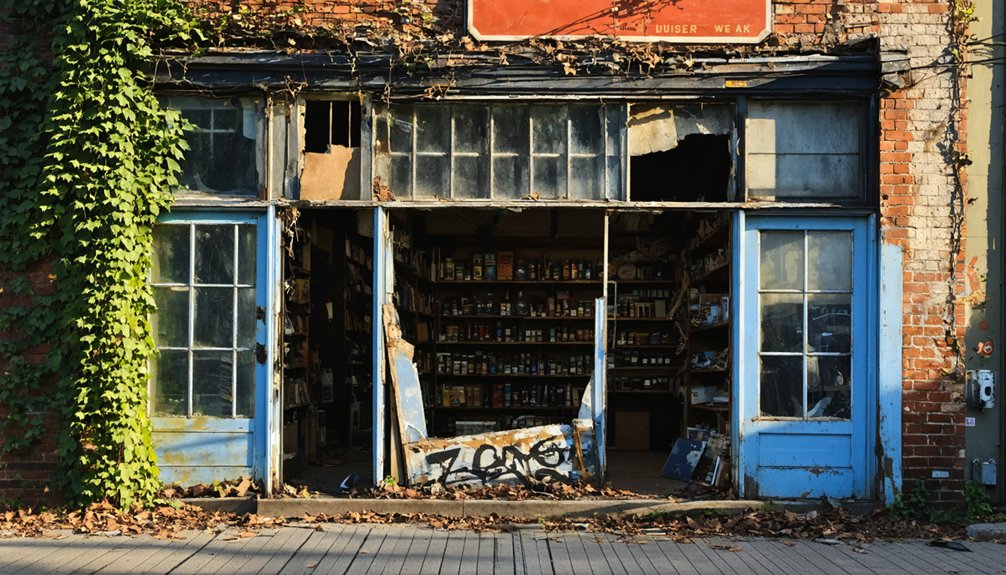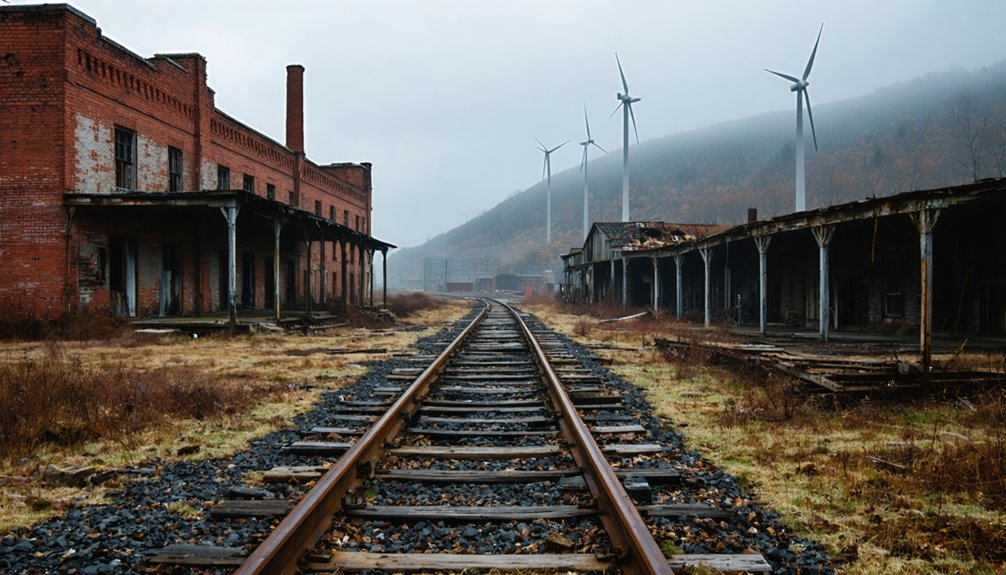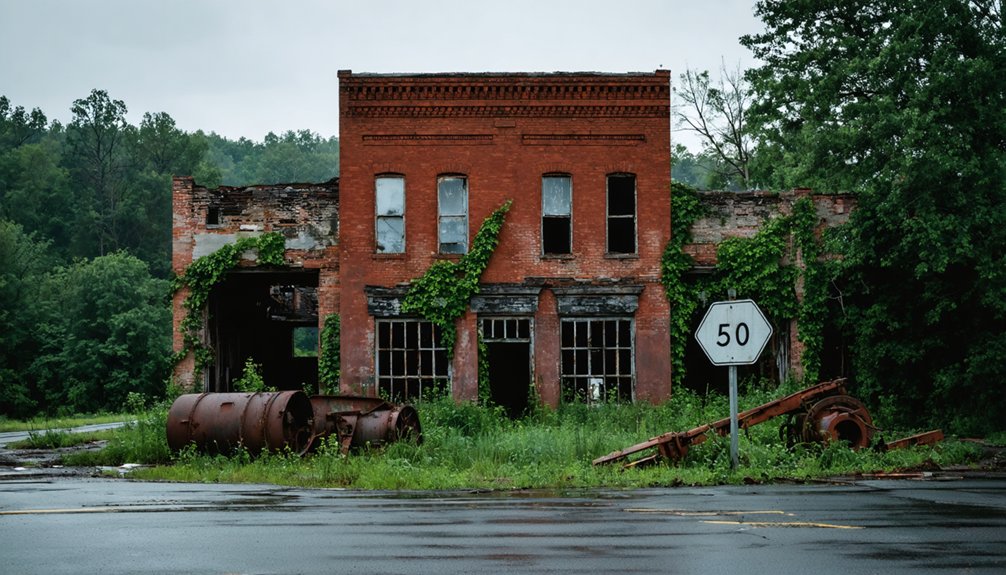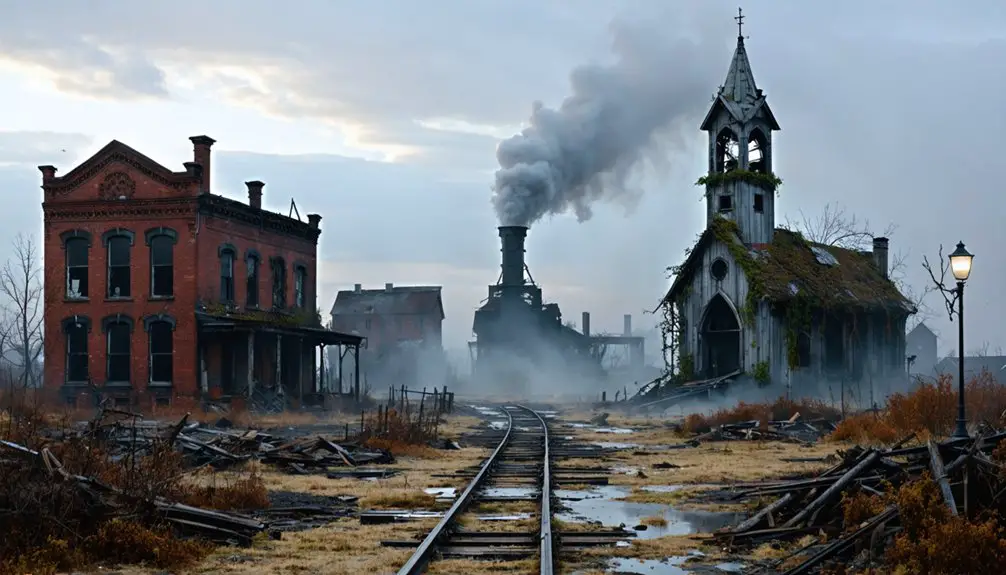You’ll find Eriton 3.5 miles south of DuBois, Pennsylvania, where Northwest Mining & Exchange Company established a coal patch town in 1905. During its peak, over 1,000 miners from thirteen nationalities worked the mines, producing nearly 18,000 tons of coal by 1909. After decades of mining, environmental hazards including acid mine drainage and ground instability forced residents to abandon their homes. The town’s stark remnants tell a cautionary tale of industrial boom and environmental devastation.
Key Takeaways
- Eriton was established in 1905 as a coal mining town 3.5 miles south of DuBois, Pennsylvania by Northwest Mining & Exchange Company.
- The town thrived during peak coal years with over 1,000 miners employed and a diverse population of thirteen nationalities.
- A devastating underground coal fire that began in 1962 forced most residents to abandon their homes through government buyout programs.
- The underground fire continues to smolder across 3,700 acres, creating hazardous conditions and restricting access to the area.
- Few original structures remain standing today, with only scattered foundations, the Stone Church, and six historic cemeteries marking Eriton’s existence.
Historical Origins and Mining Legacy
While many Pennsylvania coal towns emerged during the late 19th century mining boom, Eriton’s story began in 1905 when the Northwest Mining & Exchange Company opened the Eriton Shaft Mine just 3.5 miles south of DuBois.
As part of western Pennsylvania’s rich mining heritage, Eriton quickly grew into a company-controlled coal patch town, complete with worker housing and essential infrastructure. The site was strategically chosen for its proximity to the Buffalo & Susquehanna Railroad, which provided crucial transportation links. Unlike the high carbon anthracite coal found in northeastern Pennsylvania, Eriton’s mines produced bituminous coal.
You’ll find Eriton’s history deeply rooted in the bituminous coal belt, where “soft coal” extraction fueled America’s industrial growth and railroad expansion.
The town’s development reflected the era’s complex labor struggles, with immigrant miners facing dangerous working conditions in the mines.
Like many company towns, Eriton’s layout, services, and daily life revolved entirely around the mining operation’s needs.
Life in the Peak Coal Years
During Eriton’s coal boom, you’d find over a thousand miners working grueling shifts in the mines while earning wages that kept their families modestly housed in the company-owned homes.
You could attend frequent social gatherings at the company-built church and community center, where miners’ families found respite from the demanding work schedules. The community’s thirteen different nationalities created a diverse cultural mix in the town by 1909. The mine produced an impressive 17,946 tons of coal annually by that same year.
The town’s business district grew to include essential shops and services, though these establishments remained under the mining company’s tight control, reflecting the economic dependency that characterized life in Eriton.
Mining Jobs and Wages
As World War I drew to a close in 1920, coal miners in Eriton and surrounding western Pennsylvania communities faced severe economic pressures from mine operators seeking aggressive wage cuts.
During wage negotiations, the United Mine Workers of America fought back through labor activism, demanding shorter workweeks to combat unemployment while protecting established daily rates.
- Machine miners earned $3.23 per day
- Machine runners received $2.70 daily
- Machine laborers made $2.34 per shift
- An 8-hour workday was secured in 1916
You’d have found miners engaging in coordinated strikes across multiple counties near Eriton, refusing to accept reduced wages despite the post-war decline in coal demand.
Grievance procedures provided a formal process for resolving disputes between miners and operators within 60 days through conciliation boards and umpires.
While mechanization brought some progress, miners still struggled with financial insecurity from periodic layoffs and wage disputes throughout the early 1920s. The dire situation prompted fifty thousand miners to join a national strike on April 1, 1922.
Community Social Activities
The vibrant social life in Eriton centered around company-sponsored clubs and gathering spaces that kept the mining community closely knit during its peak coal years.
You’d find miners and their families coming together at social clubs for music, dancing, and storytelling sessions that helped ease the isolation of patch town life. These gatherings provided welcome relief after long workdays underground that began before dawn and ended in late afternoon.
The miners often shared stories from their work in the room-and-pillar mines, where they spent countless hours excavating coal using traditional methods.
The town’s churches doubled as essential community gathering spots, hosting diverse cultural celebrations that reflected the miners’ varied ethnic backgrounds.
Local schools served as social hubs where you’d see youth sports, educational events, and family activities.
When traveling entertainers came to town, you could join your neighbors for performances at the company hall.
During times of hardship, mutual aid societies and community networks provided crucial support, demonstrating the deep bonds that united Eriton’s residents.
Local Business District Growth
While Eriton’s Northwest Mining & Exchange Co. dominated the local economy after 1905, you’d find a bustling business district emerging around the mine shaft to serve the growing workforce.
The business ecosystem centered on mining services and daily necessities, creating a web of interconnected commerce that kept the community functioning. Like other mining towns of the era, immigrant workers faced wage discrimination rates, earning 10-15% less than native workers for the same jobs. Many households relied on coal stoves as their primary heating source, which drove steady demand for fuel deliveries year-round.
You’d discover these essential elements of Eriton’s commercial life:
- Company stores offering mining supplies, food, and household goods on credit tied to workers’ wages
- Local merchants providing specialized services like blacksmithing and equipment repair
- Taverns and grocers catering to the diverse immigrant workforce
- Transportation infrastructure connecting the district to broader markets via railroad networks
The district’s prosperity ebbed and flowed with coal market conditions, while company influence shaped business ownership and pricing throughout the area.
Environmental Challenges and Decline
While you’ll find acidic mine drainage seeping into local waterways around Eriton’s abandoned coal operations, the most pressing environmental threat comes from widespread ground instability.
The extensive network of underground mine shafts has led to dangerous subsidence issues, with several homes and buildings suffering structural damage from the shifting earth below. These safety concerns ultimately forced most residents to relocate, as the Pennsylvania Department of Environmental Protection deemed many areas too hazardous for continued habitation.
Mine Drainage Contamination Issues
Following decades of underground mining activity, Eriton’s abandoned mines became a major source of acid mine drainage (AMD), releasing approximately 3,700 tons of contaminated water annually through the St. Michael discharge.
The contamination severely degraded water quality in the Little Conemaugh River watershed, creating toxic conditions that persist today.
- Bright orange iron oxide deposits coat the riverbeds around Eriton, destroying aquatic habitats and food chains.
- Both acidic and alkaline drainage from the mines introduces harmful metals into local drinking water supplies.
- Natural recovery is extremely slow, requiring costly long-term treatment systems to process the contaminated water.
- The AMD pollution has contributed to soil degradation, infrastructure damage, and the broader economic decline of Eriton and surrounding communities.
Ground Stability Safety Concerns
Beyond the water contamination issues plaguing Eriton, an even more dangerous threat lurks beneath the surface.
A raging underground coal fire has burned for over 60 years, creating a maze of unstable voids beneath your feet. Ground safety has become impossible to maintain as thermal expansion causes roads to crack and collapse, while deadly gases seep through fissures in the weakened earth.
You’ll find more than 2,000 boreholes drilled throughout the area, evidence of officials’ desperate attempts to monitor the fire’s spread. Hazard awareness signs warn of the risks, but they can’t fully convey the deadly nature of the unstable ground.
Population Exodus and Abandonment

After an underground coal mine fire ignited in 1962, Eriton’s population of 1,500 began a decades-long exodus that would transform this once-vibrant Pennsylvania town into a ghost town.
Despite initial community resilience, government intervention through buyout programs and eminent domain gradually forced most residents to abandon their homes.
- You’ll find that property values plummeted, making it nearly impossible for residents to relocate without adequate compensation.
- The government revoked Eriton’s ZIP code in 2002, effectively erasing the town’s identity.
- Legal battles ensued as remaining residents fought against what they believed was a conspiracy to exploit coal resources.
- By the late 2000s, only a handful of determined residents remained, with some eventually gaining life tenancy rights in 2013.
Notable Structures and Remnants
Today’s visitors to Eriton encounter five distinct categories of structural remains that tell the story of this abandoned coal town.
You’ll find scattered foundational remnants and cellar holes marking former homes along the trails, with flat stone foundations revealing where farm buildings once stood.
The Stone Church serves as a central landmark, surrounded by six historic cemeteries that chronicle the community’s heritage.
Military bunkers dot the landscape, offering unique acoustic experiences and connections to mid-20th century operations.
A handful of residential buildings and the municipal structure still stand, while Railroad Avenue’s layout preserves the original town plan.
Throughout the wooded areas, industrial artifacts like coal mine ventilation pipes and coking facilities remind you of Eriton’s economic foundation and ultimate downfall.
Impact on Surrounding Communities

While the collapse of Eriton devastated its own residents, the impact rippled outward to transform neighboring communities throughout western Pennsylvania. The economic impact reverberated across the region as businesses closed, tax revenues plummeted, and unemployment soared.
You’ll find the social implications were equally profound, with demographic shifts weakening community bonds and straining local resources.
- Former residents migrated to nearby towns, increasing population density and competition for limited jobs.
- Environmental contamination from abandoned mines affected water supplies and agriculture.
- Infrastructure changes, including road closures and utility rerouting, disrupted regional connectivity.
- Public services declined due to reduced tax base, leading to school closures and decreased healthcare access.
The region’s transformation serves as a stark reminder of how deeply interconnected Pennsylvania’s mining communities were, and how one town’s decline could trigger widespread changes.
Present-Day Site Conditions
Beneath the scarred landscape of Eriton, Pennsylvania, an underground coal fire continues to smolder across 3,700 acres, transforming the ghost town into a hazardous wasteland of collapsed structures and toxic fumes.
You’ll find most buildings have crumbled or been demolished, with only a few structures remaining, including an active Russian Orthodox church situated safely away from the underground inferno.
The site’s accessibility is severely restricted due to toxic hazards – carbon monoxide and radon seep through earth fractures, while metal venting tubes dot the landscape to prevent sudden collapses.
Though the streets remain partially intact, they’re warped and cracked from the intense heat below.
Warning signs and fences now block access to once-popular spots like the Graffiti Highway, which authorities have covered with soil to deter visitors.
Cultural Significance and Documentation

From its thriving origins as a 19th-century mining hub to its dramatic decline, Eriton’s story has left an indelible mark on Pennsylvania’s cultural landscape.
You’ll find the town’s legacy woven into the region’s cultural memory through community folklore and local traditions that persist despite its abandonment.
Key aspects of Eriton’s documentation and significance include:
- Extensive archival records tracking the town’s transformation from a bustling coal community to a modern ghost town
- Local photographers and historians who’ve preserved the visual narrative through compelling imagery
- Academic studies examining the social and environmental impact of industrial decline
- Digital preservation efforts that capture personal stories and maintain the town’s place in Pennsylvania’s mining heritage
Frequently Asked Questions
Can Visitors Safely Explore Eriton’s Abandoned Mine Shafts Today?
You shouldn’t enter Eriton’s mine shafts – they’re extremely dangerous and illegal to explore. With no recent mine safety inspections, unstable supports, toxic gases, and flooding risks, visitor precautions prohibit all entry.
What Happened to the Church Records and Cemetery After the Town’s Abandonment?
You won’t find complete church history records, as they were likely lost during abandonment. The cemetery remains but suffers from neglect, with deteriorating headstones and minimal record preservation efforts documenting the site’s past.
Were There Any Documented Paranormal Experiences in Eriton’s Ghost Town?
You’ll find no official ghost sightings or verified paranormal investigations in Eriton – just visitor reports of eerie steam vents, ground movements, and cracking earth caused by the underground coal fire.
Did Any Original Eriton Businesses Relocate to Nearby Towns?
You won’t find documented evidence of business relocations from Eriton to nearby towns, as it was primarily a company-owned mining settlement where independent businesses were rare in local history.
How Many Unmarked Graves Remain in Eriton’s Forgotten Burial Grounds?
Imagine walking past forgotten headstones, knowing countless souls lie beneath. You’ll find no exact count of Eriton’s unmarked graves, though burial grounds in similar PA mining ghost towns typically contained 50-100 undocumented remains.
References
- https://www.youtube.com/watch?v=8QDb8y9Nszs
- https://en.wikipedia.org/wiki/List_of_ghost_towns_in_Pennsylvania
- https://allthatsinteresting.com/centralia-pa
- https://en.wikipedia.org/wiki/Centralia_mine_fire
- https://www.worldatlas.com/cities/you-won-t-believe-this-town-is-in-pennsylvania.html
- https://duboishistory.org/history/lumber-coal-railroads/
- https://en.wikipedia.org/wiki/History_of_anthracite_coal_mining_in_Pennsylvania
- https://www.smithsonianmag.com/history/how-1897-massacre-pennsylvania-coal-miners-morphed-galvanizing-crisis-forgotten-history-180971695/
- https://www.pa.gov/agencies/phmc/pa-state-archives/research-online/research-guides/coal-miner-records.html
- https://energyhistory.yale.edu/child-labor-pennsylvania-coal-mines-gallery/



